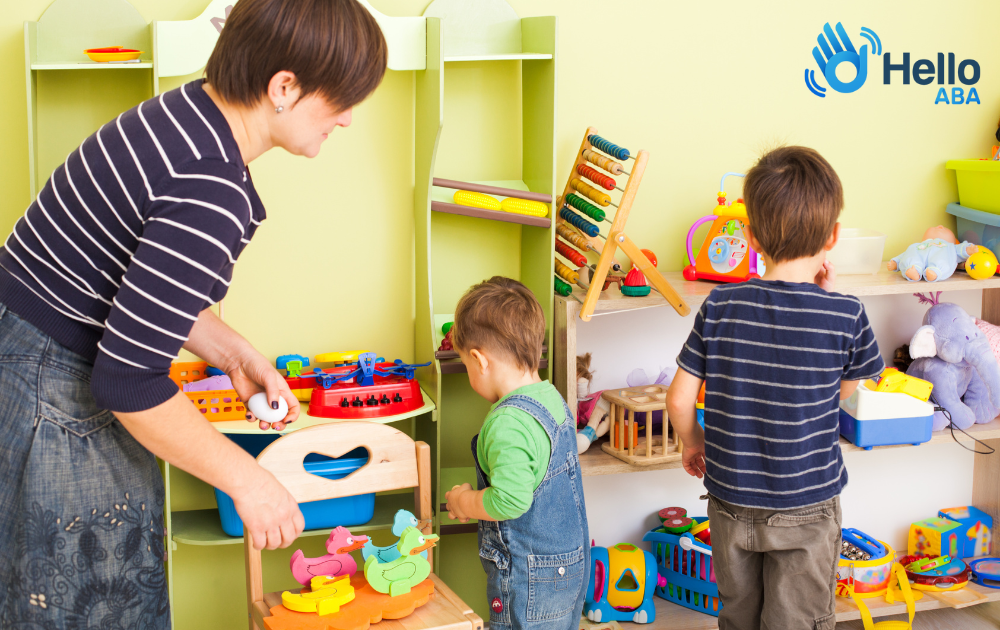Natural Environment Teaching (NET) is a personalized teaching method frequently used in ABA therapy for individuals with autism or other developmental disabilities. It emphasizes tailored teaching strategies that take into account individual strengths, needs, and interests while harnessing learning opportunities during playtime and daily routines. By incorporating natural environment teaching activities, learners can experience authentic learning experiences that have real-world relevance.
What Is Natural Environment Teaching (NET)?
The goal of Natural Environment Teaching is to provide learners with meaningful and contextually relevant learning experiences in natural environments. This approach allows for the application of learned skills in real-life situations, promoting generalization and transferability of skills. By teaching in natural environments, such as the home, community, or school, learners have the opportunity to practice skills in the settings where they will be used.
The benefits of Natural Environment Teaching are numerous. Firstly, it provides authentic learning experiences that are engaging and relevant to the learner’s daily life. This can increase motivation and active participation in the learning process. Additionally, natural environment teaching allows for the use of positive reinforcement strategies, which can further enhance motivation and encourage desired behaviors.
Moreover, Natural Environment Teaching promotes the transfer of skills from the therapy setting to real-life situations. By practicing skills in natural environments, learners have the opportunity to apply what they have learned to various contexts, improving their ability to generalize skills. This transferability of skills is essential for individuals with autism to function independently and adapt to different situations.
Another significant benefit of Natural Environment Teaching is the reduction of monotony often associated with traditional teaching methods. By incorporating teaching strategies into playtime and daily routines, learning becomes more enjoyable and less rigid. This can help maintain the learner’s engagement and enthusiasm for learning.

Strategies and Techniques
Natural Environment Teaching encompasses various strategies and techniques that aim to facilitate meaningful and contextually relevant learning experiences in natural environments. Some commonly used techniques include:
- Incidental Learning: This technique involves taking advantage of naturally occurring teaching opportunities that arise during everyday activities. It focuses on embedding teaching moments into the learner’s natural environment, allowing for spontaneous learning.
- Environmental Prompting: Environmental prompts are cues or stimuli within the learner’s environment that can help elicit a desired behavior or response. By strategically arranging the environment, prompts can be used to support the learner’s understanding and encourage targeted behaviors.
- Peer-Mediated Play: Peer-mediated play involves facilitating interactions between the learner and their peers. This technique encourages socialization and provides opportunities for the learner to practice social skills in a natural setting.
- Activity Scaffolding: Activity scaffolding involves providing support and guidance to the learner during an activity. The level of support is gradually decreased as the learner becomes more independent and proficient in the targeted skills.
- Functional Routine-Based Intervention: This technique focuses on teaching skills within the context of functional routines, such as mealtime or bedtime. By embedding teaching moments into these routines, learners have the opportunity to practice skills that are directly applicable to their daily lives.
Implementing these strategies and techniques, Natural Environment Teaching aims to create a dynamic learning environment that maximizes the learner’s engagement and promotes the application of skills in real-life situations.

Implementing NET at Home
To further enhance learning opportunities for children with Autism Spectrum Disorder (ASD) at home, implementing Natural Environment Teaching (NET) activities can be highly beneficial. NET activities provide practical and engaging ways to promote learning in a natural and familiar setting. Let’s explore some practical activities and strategies for incorporating learning into daily routines.
Practical Natural Environment Teaching Activities
NET activities can be seamlessly integrated into daily routines, turning everyday moments into learning adventures. Here are some examples of practical activities parents and caregivers can implement at home:
- Sorting Colors: Engage your child in sorting objects by color, such as toys or clothes. This activity promotes color recognition and categorization skills.
- Counting with Bath Toys: Take advantage of bath time to practice counting skills. Encourage your child to count bath toys as they play, making it a fun and interactive learning experience.
- Following Instructions while Preparing Snacks: Involve your child in simple snack preparation activities, such as spreading peanut butter on bread or arranging fruits on a plate. This activity helps develop fine motor skills, sequencing abilities, and following instructions.
- Developing Spatial Reasoning through Building Exercises: Use building blocks or Legos to engage your child in spatial reasoning activities. Encourage them to create structures, solve puzzles, or build patterns, fostering cognitive development and problem-solving skills.
These practical activities provide opportunities for learning while engaging in daily routines, making the learning experience enjoyable and effective.
Incorporating Learning in Daily Routines
In addition to specific activities, integrating learning into daily routines can support continuous learning and skill development. Here are some strategies for incorporating learning into daily routines:
- Mealtime Learning: Encourage your child to participate in mealtime activities, such as setting the table or identifying healthy food choices. This promotes independence, social skills, and nutritional awareness.
- Chores and Responsibilities: Assign age-appropriate chores and responsibilities to your child, such as tidying up toys, making the bed, or feeding pets. These tasks help develop a sense of responsibility, organizational skills, and independence.
- Community Outings: Plan outings to community settings, such as parks, libraries, or grocery stores. These outings provide opportunities for socialization, sensory exploration, and generalization of learned skills beyond the home environment.
Incorporating learning into daily routines allows children with ASD to practice and generalize skills in a natural and meaningful way. Providing positive reinforcement, praise, and support throughout these activities motivates and encourages your child’s progress.

Advantages of NET in ABA Therapy
Incorporating Natural Environment Teaching (NET) activities into Applied Behavior Analysis (ABA) therapy offers several advantages for learners with autism. NET provides a dynamic learning environment, preventing burnout and monotony for both therapists and clients.
Dynamic Learning Environment
One of the key advantages of implementing NET in ABA therapy is the creation of a dynamic learning environment. Unlike traditional clinical settings, NET activities take place in real-world settings, such as the home, community, or school. This allows learners to practice and generalize skills in the same contexts where they will naturally use them.
Engaging in activities within their natural environment allows learners to apply skills in real-life situations, enhancing their understanding and retention of the targeted behaviors. This authentic learning experience promotes a deeper understanding of the skills being taught and increases the likelihood of skill generalization.

Preventing Burnout and Monotony
In traditional clinical settings, the repetitive nature of therapy sessions can sometimes lead to burnout and monotony for both therapists and clients. However, incorporating NET activities into ABA therapy can help alleviate these challenges.
For clients, participating in NET activities adds excitement and interest to their therapy sessions. Activities that take place in familiar environments, such as playtime at home or outings in the community, can be more engaging and enjoyable for learners. This increased motivation and enthusiasm contribute to a more effective and productive learning experience.
The advantages of NET in ABA therapy extend beyond the prevention of burnout and monotony. NET activities also focus on fostering socially appropriate behaviors and providing a personalized therapy approach.
Effective Integration of NET Activities
To ensure the effectiveness of Natural Environment Teaching (NET) activities, it is important to consider two key aspects: spontaneous engagement and structured goal setting.
Spontaneous Engagement
One of the strengths of NET activities is their ability to engage learners in a spontaneous and natural manner. Unlike traditional teaching methods that are often structured and predictable, NET encourages learning opportunities to arise naturally in the environment. This spontaneous engagement allows learners to generalize the skills they have learned in a more meaningful and contextually relevant way.
Incorporating NET activities during break times or free play allows instructors to create opportunities for learners to practice and reinforce skills taught in a structured setting. For instance, during playtime, an instructor can engage a learner in a conversation about their favorite toy or encourage them to use newly acquired social skills with peers. These spontaneous interactions enhance the learner’s engagement and promote the generalization of skills beyond the therapy setting.
Structured Goal Setting
While spontaneity is a key component of NET activities, structured goal setting is equally important. Instructors and therapists should have a clear plan in mind and set specific goals for each NET session. This helps to ensure that the activities are purposeful and targeted, maximizing the learning opportunities for the learner.
To facilitate structured goal setting, instructors can write down goals and examples on whiteboards or other visual aids during NET programs. This visual representation helps keep the focus on relevant goals and reduces the reliance on unstructured playtime. By having clear goals in mind, instructors can guide the learner’s activities and interactions, ensuring that the desired skills are being practiced and reinforced.
Combining spontaneous engagement with structured goal setting, NET activities can be highly effective in promoting learning and skill generalization. These methods not only make the learning experience more enjoyable and meaningful for learners but also provide opportunities for instructors and therapists to observe and assess progress in a natural environment.

Starting NET in ABA
Beginning Natural Environment Teaching (NET) in Applied Behavior Analysis (ABA) involves adopting a fun and engaging learning approach that focuses on socialization skills. Creating a positive and enjoyable learning environment allows individuals with Autism Spectrum Disorder (ASD) to develop important skills while having fun.
Fun Learning Approach
Starting NET in ABA involves making the learning experience enjoyable and exciting for individuals with ASD. Instead of demanding answers, therapists focus on commenting, modeling, and celebrating responses. This approach encourages active participation and creates a positive atmosphere that motivates individuals to engage in the learning process.
Incorporating play-based activities and integrating the child’s interests allows therapists to capture the individual’s attention and promote active learning. This fun learning approach not only enhances motivation but also helps establish a strong therapeutic relationship between the therapist and the individual.
Focus on Socialization Skills
One of the key benefits of implementing NET in ABA is the focus on developing socialization skills. Naturalistic teaching methods have proven particularly effective for individuals with ASD in developing these crucial skills, which are essential for leading a happy and healthy life.
NET allows children with ASD to learn socially appropriate behaviors within their everyday environments, such as school, playground, home, and the community. This approach goes beyond the clinical setting and enhances the practical application of learned skills. By practicing socialization skills in real-life situations, individuals with ASD can generalize these skills across different contexts and interact more effectively with peers, family members, and the community.
Therapists using NET in ABA work on specific target behaviors associated with the child’s daily activities and routines. This personalized approach allows therapists to tailor the therapy to the individual child’s unique experiences. By focusing on the child’s interests and incorporating their preferences into therapy sessions, therapists create a more engaging and effective learning experience.
Starting NET in ABA with a fun learning approach and a focus on socialization skills allows individuals with ASD to benefit from a personalized and engaging therapy experience. This approach promotes skill development and enhances the overall well-being and quality of life for individuals with ASD.

Impact of Naturalistic Teaching
Tailoring therapy to the individual’s specific needs and interests makes naturalistic teaching more meaningful and effective. Children have control over the toys and activities they engage with during therapy sessions, allowing them to set their own pace and participate in activities they enjoy. This level of engagement promotes active participation and increases motivation, thereby making the therapy more effective in achieving targeted outcomes.
Naturalistic teaching, with its focus on the natural environment, has a profound impact on the development and progress of individuals with ASD. This teaching method recognizes the unique experiences and needs of each individual with ASD. Therapists work closely with the individual to identify target behaviors that are associated with their daily activities and routines.
The personalized therapy approach of naturalistic teaching also allows therapists to address specific challenges that individuals with ASD may face in their daily lives. By targeting behaviors within the context of their natural environment, therapists can work on skills that are directly applicable to the individual’s everyday routines and interactions.
Incorporating evidence-based practices like Incidental Teaching, Pivotal Response Training, and Natural Language Paradigm, naturalistic teaching focuses on increasing motivation to speak, addressing the underlying causes of behaviors, and promoting communication skills in non-verbal children, respectively. These practices further enhance the personalized therapy approach by targeting specific areas of development and tailoring interventions to the individual’s unique needs.
For those seeking ABA Therapy in Maryland, Hello ABA provides expert ABA therapy tailored to individual needs. Contact us today to schedule a consultation or book an appointment.






